With the official launch of Celebration of Early Astronomy 3, here is the full information for Leg 1 of the expedition!
Start Date: July 3, 2021
End Date: July 17, 2021
Map, (click for full size):

Basecamp: Merrill’s Star
Main Waypoints
- Map References quick reference list, more details below
- Keltim
- BD+06 3756
- CoRoT-9
- R Scuti
- CoRoT-27
- NGC 6755 MMU 3
- HD 181709
- HD 339086
- Merrill’s Star
Main Waypoints Details
- Map Reference: Keltim
- POI: GL 149
- Our faction’s home system, Keltim is also the real binary star pair known as GL 149, containing the stars CD-24 1826 and WT 1402.
- SIMBAD Link
- Map Reference: BD+06 3756
- POI: NGC 6633 48
- Chemically peculiar star in IC 4756, more info on IC 4756 in next listed waypoint
- SIMBAD Link
- Map Reference: CoRoT-9
- POI: IC 4756 & CoRoT-9b
- This waypoint is for both a stellar cluster and a confirmed extrasolar planet. The stellar cluster IC 4756 is a bright stellar cluster in the Serpens constellation, bright enough to be seen with the naked eye. It is also known as Graff’s Cluster after astronomy Kasimir Graff. Additionally the system known as CoRoT-9 is located within this cluster and contains the confirmed extrasolar planet of CoRoT-9b (CoRoT-9 1 in-game). The CoRoT catalog is the result of a space telescope mission looking for extrasolar planets. Systems named in the CoRoT catalog will have confirmed extrasolar planets.
The SIMBAD Strabsourg link for CoRoT-9b is: https://simbad.u-strasbg.fr/simbad/sim-id?Ident=%405278222&Name=CoRoT-9b and the SIMBAD Strasbourg link for IC 4756 is: https://simbad.u-strasbg.fr/simbad/sim-id?Ident=IC+4756
- Map Reference: R Scuti
- R Scuti is the brightest known of the RV-Tau-Type stars, and is also a yellow supergiant. It is located in the sky within the Scutum constellation. It’s brightness varies and is visibe to the naked eye at ti’s brightest, and visible with telescope or binoculars when it is dimmer.
RV Tauri variables often have somewhat irregular light curves, both in amplitude and period, but R Scuti is extreme. It has one of the longest periods known for an RV Tau variable, and the light curve has a number of unusual features: occasional extreme minima; intermittent standstills with only small erratic variation that may last for years; and periods of chaotic brightness changes.
For more information regarding the peculiarities of R Scuti you can check out it’s page on Wikipedia for a brief overview of them: https://en.wikipedia.org/wiki/R_Scuti - SIMBAD Link
- R Scuti is the brightest known of the RV-Tau-Type stars, and is also a yellow supergiant. It is located in the sky within the Scutum constellation. It’s brightness varies and is visibe to the naked eye at ti’s brightest, and visible with telescope or binoculars when it is dimmer.
- Map Reference: CoRoT-27
- POI: CoRoT-27b (exoplanet)
- CoRoT-27b is a confirmed exoplanet of around the size of Jupiter orbiting close to the star CoRoT-27
- SIMBAD Link
- Map Reference: NGC 6755 MMU 3
- POI: NGC 6755
- NGC 6755 is an open cluster of stars within the constellation Aquila
- SIMBAD Link
- Map Reference: HD 181709
- HD 181709 is one of the brighter stars within the confines of the Aquila constellation, however not quite bright enough for naked eye observation. It is a B-class star.
- SIMBAD Link
- Map Reference: HD 339086
- A B-class type star within the confines of the Vulpecula constellation
- SIMBAD Link
- Map Reference: Merrill’s Star
- Also known as WR 124 and/or QR Sagittae, it is a Wolf-Rayet type star discovered in 1938 by Paul W. Merrill. Besides being a Wolf-Rayet it is also surrounded by the planetary nebula M1-67, and is one of the fastest runaway stars known in the Milky Way Galaxy with a radial velocity of about 200 km/s
- SIMBAD Link
Optional Waypoints
- Map References quick reference list, more details below
- Keltim
- Alpha Cygni
- Veil West Sector DL-Y d68
- IC 4665 P 351
- BD+06 3756
- CoRoT-6
- CoRoT-9
- Nu Aquilae
- CoRoT-16
- CoRoT-17
- Y Ophiuchi
- R Scuti
- Trifid Sector DL-Y d157
- CoRoT-27
- NGC 6755 MMU 3
- HD 181709
- PSR J1901+0716
- HD 339086
- Campbell’s Hydrogen Star
- Merrill’s Star
Optional Waypoints Details
- Map Reference: Alpha Cygni
- AKA: Deneb
- The brightest star in the Cygni constellation, and 19th brightest star in the night sky. It represents the tail of the swan in the Cygnus constellation. This star is the star ionizing the North America Nebula and Pelican Nebula. Was also featured multiple times in the science fiction series Star Trek.
- SIMBAD Link
- Map Reference: Veil West Sector DL-Y d68
- POI: Veil Nebula West
- Designated as NGC 6960, a nebula in the Cygnus constellation and constitutes the visible portions of the Cygnus Loop. It is the remnants of a supernova. It is also sometimes referred to as the Cirrus Nebula or the Filamentary Nebula.
Additional viewing site suggestion: Veil West Sector PD-S B4-2, puts it nearly in line with Barnard’s Loop for a spectacular view. - SIMBAD Link
- Map Reference: IC 4665 P 351
- IC 4665, also known as Collinder 349 and/or Melotte 179 is an open cluster. It was discovered by Philippe Loys de Chéseaux in 1745. It is a very young cluster, having begun development “only” 40 million years ago. Lying only about 1,400 lightyears from our solar system it can easily be found with telescopes or binoculars, and in a dark enough sky may even be spottable with the naked eye. It is the brightest stellar cluster that wasn’t catalogued by Charles Messier or William Herschel.
- SIMBAD Link
- Map Reference: CoRoT-6
- POI: CoRoT-6b (exoplanet)
- CoRoT-6b is a confirmed extrasolar planet.
- SIMBAD Link
- Map Reference: Nu Aquilae
- Nu Aquilae is a double star in the constellation Aquila that lies close to the celestial equator. It is bright enough to be visible to the naked eye.
- SIMBAD Link
- Map Reference: CoRoT-16
- POI: CoRoT-16b (exoplanet)
- CoRoT-16b, like the other CoRoT waypoints is a confirmed extrasolar planet.
- SIMBAD Link
- Map Reference: CoRoT-17
- POI: CoRoT-17b (exoplanet)
- CoRoT-17b, like the other CoRoT waypoints is a confirmed extrasolar planet.
- SIMBAD Link
- Map Reference: Y Ophiuchi
- Y Ophiuchi is a supergiant pulsating Delta Cepheid variable type, which means that its size changes over time. With a maginatude between 6.476 and 6.009 it should be visiblet o the naked eye in fairly dark skies. It’s pulsation period is 17.1 days in length.
- SIMBAD Link
- Map Reference: Trifid Sector DL-Y d157
- POI: Trifid Nebula
- While the in-game representation of the nebula is not a handcrafted one, and not representative of how it looks in reality, the Trifid Nebula, AKA Messier 20 is a combination of an open cluster of stars, an emission nebula, and a dark nebula. The most massive star in the Trifid Nebula is HD 164492A, an O-class star with a mass more than 20x that of our sun (although not in-game).
CMDR Henry Killinger has noted that there are unique NSPs in the following three systems within this area as well: Trifid Sector FW-W d1-233, Trifid Sector DL-Y d157, Trifid Sector BQ-Y d244 - SIMBAD Link
- Map Reference: PSR J1901+0716
- This pulsar is known to undergo episodic changes in its emission profile at roughly 2 minute intervals, but not with entirely consistent spacing.
More information: https://www.researchgate.net/figure/Time-versus-phase-for-an-8-minute-observation-of-PSR-J1901-0716-showing-several_fig6_339471094 - SIMBAD Link
- This pulsar is known to undergo episodic changes in its emission profile at roughly 2 minute intervals, but not with entirely consistent spacing.
- Map Reference: Campbell’s Hydrogen Star
- Also known as HD 184738, Campbell’s Hydrogen Star is a Wolf-Rayet type star at the center of a planetary nebula. It is named after astronomer William Wallace Campbell who discovered it in 1893.
- SIMBAD Link
